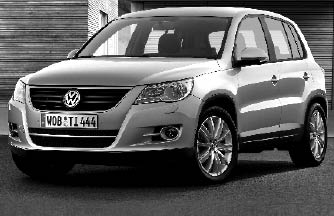What's In a Name?
by Jim Corbran

Luckily for Volkswagen, most people don’t base their vehicle purchase based solely on its name. Tiguan? I dunno, either. All I do know is that I found it much easier when VW’s car names were…well, when they were actual words I recognized. Beetle. Bug. Squareback and Fastback. Even the Karmann-Ghia name made sense once you realized Karmann was the coachbuilder (body fabricator) and Ghia was the designer.
Anyway, according to a Netherlands-based Tiguan fan’s Web page (tiguan.nl/passage/personal/goertz), Tiguan is “a fusion of the words ‘tiger’ and ‘leguan’ (German for ‘iguana’).” Another source tells us it’s a Chochimie (Indian dialect) word for “fertile meadow,” or “close to the water.” Maybe it’s all of those. Or none of those. And this fine moniker, believe it or not, was voted on over four others (Nanuk, Namib, Rockton and Samun) by more than 350,000 readers of Germany’s Auto Bild magazine. What’s in the water over there?
Somewhere along the line, VW’s marketing people got off the track. Passat. Quantuum. Jetta. At least New Beetle made sense. Then came the Touareg. At first, pronunciation guides told us it was “TWA-regg,” and the name had some connection to a nomadic tribe. Then all of the sudden we were told it’s “TOUR- egg,” which at least is pronounced as it looks; the jury’s still out on whether or not it’s a good name.
Now here comes Tiguan. “TIGG-wann.” It’s VW’s long-overdue entry into the small SUV market. And it couldn’t be coming at a better time. With US gas prices still hanging in there at just above three bucks a gallon, the large SUV’s days are bound to be numbered. VW’s lone entry in the SUV market has been the Touareg, which is a great vehicle with an unfortunate high price and a thirst for petrol. Outside of North America VW sells a diesel Touareg, which gets better gas mileage, but doesn’t meet current emissions standards in most US states. (That will soon be changing, but that’s another story for another week.)
All of the news of the Tiguan is not related to its unusual name. There’s a vehicle in here somewhere that we should talk about. It is slated to begin US sales sometime next spring. It will be formally introduced to the motoring world at the Frankfort Auto Show in Germany this September, and be available to European buyers shortly thereafter. A few weeks back VW finishing testing the preproduction model in Namibia, in southwest Africa. Testing was done there as VW feels the Tiguan, like the Touareg, will be a true off-road vehicle should its buyers be so inclined. The US version will initially come equipped with VW’s 2.0-liter, 200-horsepower, turbocharged four from the GTI, followed sometime later by a clean diesel model. (Three other engines, two diesel and one gasoline powered, will also be offered outside of North America.) All engines, here and abroad, will be turbocharged. This is a first for VW, to have an entire line equipped with turbocharged engines. It’s one way (some say the best way) to get the most power out of the smallest sized engines. Anyone who’s ever driven a GTI to its redline would certainly agree.
The Tiguan is based on a Rabbit (Golf) platform. From any angle there’s no mistaking it for a VW. Squint from far away and you could mistake it for either the Touareg or the Rabbit. It’s short front and rear overhangs were designed with the steep angles often encountered during off-roading (both the intentional and unintentional varieties?). It’s expected that both six-speed manual and automatic transmissions will be offered.
Look for a full-drive report here as soon as it’s available. In the meantime, let me know what you think a “Tiguan” is. Mexican cat? Herbal drink? Or was he the guy who played the Mod Squad’s boss in the old TV series?
More info: www.tiguan-base.com.
|
Issue Navigation> Issue Index > v6n30: Yum! (Delicious Art) (7/26/07) > What's In a Name? This Week's Issue • Artvoice Daily • Artvoice TV • Events Calendar • Classifieds |









 Current Issue
Current Issue